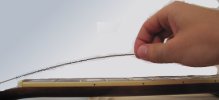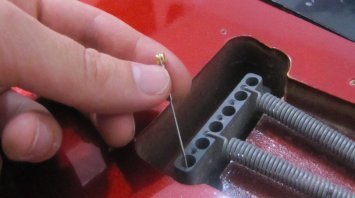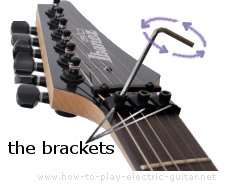Changing Electric Guitar Strings
There are a number of electric guitar constructions and changing electric guitar strings slightly varies from one guitar to another.
In this article I have covered almost all types of guitars and have divided the article into the following chunks.
• Chapter 1 Contains useful tips before you begin restringing that are correct for any electric guitar.
• Chapter 2 - Replacing the Strings.
This is the main "how to" part. Although this chunk is focused on guitars without a whammy bar.

Here you'll also find useful tips related to any electric guitar.
• In Chapter 3 I explain certain nuances of restringing a guitar with a synchronized vibrato.
This is the most common vibrato system that can be found on Fender/Squier Strat guitars and many, many others.

• In Chapter 4, I talk about guitars with a locking vibrato system (Floyd Rose, Ibanez Edge).
These guitars have a locking nut that prevents strings from moving near the guitar head and fine-tuners on the guitar bridge.

Many Ibanez and Jackson guitars have a locking vibrato system like this.
Chapter 1 - Before you begun restringing
there's a couple of reasons why you would want to change electric guitar strings.
1. The strings get older and degraded over time, resulting in a duller sound that often accompanies unpleasant vibrations, especially on the high E string.
2. You need to experiment with different string gauges to find what works better for you.
In the first case restringing is straightforward, in the second you might need to make some extra adjustments to your guitar (such as intonation, action, neck...), especially if it has a whammy bar. You need to have much more time available and patience to accomplish this.
What I noticed over the years is that the first string that goes out of shape and sounds poor is the high E string, sometimes the B string goes soon after it.
While the rest of the strings stay good for a really long time after that. This led me to a conclusion that will save time:
I manage without full restringing for a much longer time by changing just the high E and B string when necessary and leave the other strings only for some cleaning with fast-fret string cleaner. This product smooths the surface of the strings allowing you to play faster, and extending their durability.
I change all the strings only when they become rusty or the overall sound becomes poor, or when I need really superior sound for important recording sessions.
No matter what type of a guitar you're going to restring, the safest way to do so is to remove and replace one string at a time. Removing all the strings can change neck position, and will require a qualified specialist to make the adjustments.
Another good reason to restring one string at a time is - if you are confused, you can always watch how a nearby string is installed and install a new one in a similar way.
It's better to begin with the low E string (the thickest one) and go towards the high E. This way you'll have less pitch changes for the rest of the strings, so tuning will be easier.
Replacing the Strings
Removing a string
1. Turn the peg of the tuning machine belonging to the string you're going to change in a way that loosens the string's tension until you can easily unwind the rest of the string from the tuning pole with your hands.
2. Unwind and remove the string from the tuning machine.
Now you'll need to remove the string from the bridge.
3. Push the string near the bridge, so the ball-end will slide out from the hole in the bridge where it's positioned.
4. Pull the ball-end of the string and remove it from the bridge.
Tips and tricks:
Be careful not to scratch your hardware while removing the crooked end of the string from the bridge.
You can cut it if necessary, but I recommend you avoid cutting until you acquire some experience in restringing because you can over-tighten and break the new string while tuning it. In this situation the old string could be your backup until you buy a replacement.
Now if necessary you can easily access and clean up the spots under the removed string. Before you start installing the new string, it's better to lubricate the grooves where the string goes through, such as in the nut and bridge.
This should prevent the string from sticking in these grooves, improving tuning stability and decreasing the chances of string breakage.
Installing a new string
1. Pass the new string through the hole in the bridge from which you removed the old string. The sharp end goes towards the guitar head.
Make sure that the ball-end rests inside the hole, and doesn't protrude from the slot.

2. Now pass the sharp end through the hole in the pole of the tuning machine,

and pull the string through. But don't tighten it. Instead, leave about 1.5 inches (38 mm) to hang loosely. Keep more slack for the thicker strings and less for the thinner.

3. Turn up the free end of the string out of the tuning machine.

4. Begin to tighten the string by turning the peg of the tuning machine. If the string moves through the hole, fix it with your hand until the string will have some tension.
(The string coils on the post from the hole, towards the tuning machine.)

In these directions:

5. When the string just becomes tight, make sure that it lays down correctly on the grooves in the bridge and the nut. If the string whips out from them, gently put it back on the grooves without force.
You can always look at the nearby string to check that everything's correct.
• When you have finished installing the new strings, it's time to stretch them out. Without stretching, the strings will gradually stretch on their own, annoyingly detuning your instrument, especially when you play bend notes.
Here is how to stretch the strings:
Begin with the low E string towards the highest, one by one.
Bend a string up or down a few times with both your hands, check and adjust the tuning.
Now bend the string again. This time the change in pitch should be less. Adjust the tuning and bend some more.
If the string stays in tune after the bending, switch to a nearby string and repeat the process.
• When the stretching is finished, you can cut the excess off the new strings that protrude from the tuning posts using pliers with sharp edges for cutting cables or a special string cutter.
Now enjoy your playing!
Specialises in Replacing Strings on a Guitar With a Synchronized Vibrato System
The process of changing strings on a guitar with a synchronized vibrato is the same as the previous method (on a guitar without a whammy bar), with a couple of nuances:

First you'll need to remove the rectangular cover in the back of the guitar body, using a screw-driver. It lets you access the internal vibrato gear.
Here you'll see a metal box with springs attached to it.
This box has six slots that hold ball-ends of the strings, similar to the previous chapter on guitars without a w/bar.

Removing and installing new strings happens through this box inside the guitar.

Another nuance is:
If lubricating the grooves and saddles through which the strings pass was desirable on a guitar without a whammy bar, on a guitar with a w/bar it becomes a must.
Otherwise you'll go out of tune when using the bar.
Read How to Drastically Improve Guitar Tuning Stability When Using a Whammy Bar for more details.
Now navigate to the chapter 2, and change the strings bearing in mind this information.
Specialises in Replacing Strings on a Guitar With a Locking Vibrato System
There are more differences in removing and installing strings on these guitars.
In order to change the strings you'll need:
- an appropriate allen key wrench (usually provided with a new guitar)
- a string cutter (you can also use pliers with sharp edges for cutting cables).
Here is step by step guide for changing electric guitar strings if your instrument has a locking vibrato system:
Removing a string
• Loosen the screw that holds the string locking bracket near the nut.

• Loosen the string by rotating the tuning peg until there's no tension in the string.

• Loosen the string stopper screw (1) on the bridge and remove the string from the saddle (2).

• Now unwind and remove the other end of the string from the tuning post on the head of the guitar.
Installing a new string
• Set the fine tuners (3) on the bridge about the middle of their tuning range, so later on you'll have some space for both tightening and loosening the string while making fine tuning adjustments.
• Cut off the ball end of new string.

• Place the cut side in the groove between the saddle (2) and the string holder block (4).
• Fix the end of the string by tightening the string stopper screw (1).
The rest of the string installation routine is the same as I described in the chapter 2, beginning from here →
Note
Use the tuning machines on the guitar head to tune the guitar when installing and stretching the strings or for retuning the guitar to a completely different pitch (Alternate Guitar Tuning).
If you find the guitar slightly goes out of tune when you are practicing, use the fine-tuners on the bridge to adjust the tuning.
